Given how central work is to the lives of many Americans, the federal government carefully and consistently collects information on job availability, job characteristics and the demographics of the workforce. This chapter presents some of the key indicators collected by federal agencies and, when available, how they have changed over the past couple of decades. These topics include:
- The share of U.S. workers who are looking for work, and how long employees have worked for their current employer
- How much workers earn, how they are paid, and how much control they have over their work goals and processes
- How the age diversity, racial and ethnic diversity, and education of the U.S. workforce has changed in recent decades
How easy is it to find and keep a job?
National unemployment rate

The standard measure of the availability of jobs is the national unemployment rate, or the share of the labor force who is looking for work. A low unemployment rate implies that it is relatively easy for job seekers to secure employment.
In 2023, unemployment was 3.6%. Over the past seven decades, there have been very few years with an unemployment rate lower than that.
Though unemployment has ticked up during 2024, it remains relatively low – 4.1% in October 2024.
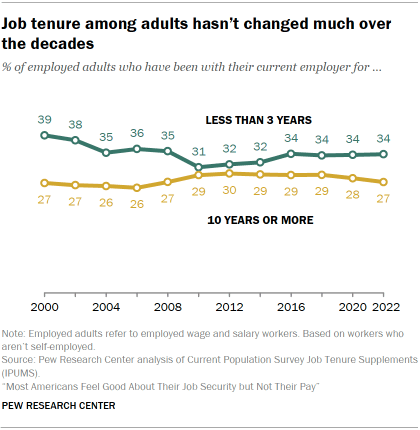
By comparison, unemployment peaked at 9.7% in 2010 after millions of workers lost their jobs in the Great Recession that began in December 2007.4
Job tenure
Job tenure data collected by the government also indicates that jobs have become more secure over the last few decades and that workers are not job-hopping more than in the past.
Every other January, the U.S. Census Bureau asks workers how long they have been with their current employer. In January 2022, about a third of workers ages 18 and older (34%) reported that they had been with their current employer less than three years, while about one quarter (27%) had been with their employer 10 years or more. The average tenure of today’s workers is not much different than what was reported by workers 20 years ago.
The tenure data captures workers who choose to leave their job (if they quit or job-hop) as well as those who leave involuntarily (if they get fired).
Job tenure appears to have increased during the Great Recession. For example, in January 2008, 35% of workers had been with their employer less than three years. But by 2010, 31% of workers reported that short of tenure. During economic downturns, workers may stick with their current employer due to the lack of good alternative job opportunities. Furthermore, employees with short tenures are the ones who are most likely to be terminated during a recession and thus no longer included in the tenure calculation.
Job tenure among adult workers partly reflects the characteristics of the workforce. Over many decades, the workforce has aged; that tends to boost the average job tenure, as older workers generally stay in their jobs longer than younger workers.
Still, the job tenure of 18- to 34-year-old workers has not changed much over time. This suggests that today’s young workers do not job-hop to a greater extent than young workers of the past.
Job characteristics
How has pay changed over time?
The past decade or so has been beneficial for workers in general. Unemployment has been trending down and employers have had difficulty finding workers to fill both lower-skilled and higher-skilled jobs. As a result employers have had to pay higher wages to find the workers they need.
Today the typical adult working full-time, year-round earns about $60,000 a year.5 That’s a 12% pay boost above what they earned in 2000 ($53,480 after adjusting for inflation).6
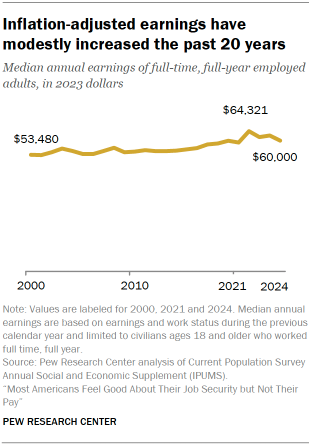
Earnings outcomes are less rosy, however, over the short term. Since 2020, inflation has heated up and workers’ pay overall has not kept up. In 2021, the median adult full-time, year-round worker earned $64,321 after adjusting for inflation, above the $60,000 earned today.
The 2021 figure refers to the earnings of workers during calendar year 2020. In 2020 there were 14 million fewer full-time, full-year workers than in 2019, the largest year-to-year decline on record. The Census Bureau asserts that the employment decline and earnings increase from 2019 to 2020 together suggest that many of the jobs lost due to the pandemic were lower-paying jobs, bumping up the estimated 2021 median earnings.
How are workers paid?
By far, wages and salaries are the most common type of pay arrangement. In 2023, 97% of workers ages 18 and older reported receiving this type of pay.
Other types of pay included:
- Bonuses (10% of workers received this type of pay)
- Commissions (5%)
- Overtime pay (5%)
- Tips (2%)
Pay arrangements vary by occupation, and workers can report multiple types of earnings.
Decision-making on the job
Another important aspect of work is the degree to which workers make their own decisions, or their autonomy on the job. The Federal Reserve has recently begun collecting information on job autonomy.
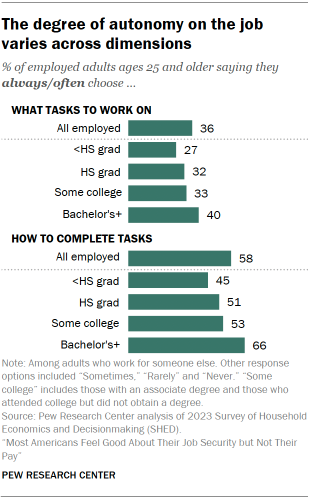
In 2023, workers said they had more autonomy to choose how to complete their tasks than to choose which tasks to complete.
Among workers ages 25 and older:
- 58% said they often or always chose how to complete tasks.
- 36% said they often or always chose which tasks to work on.
Workers with more formal education reported greater autonomy on the job than their counterparts with less education. For example, 40% of workers with at least a bachelor’s degree said they often or always choose which tasks to work on versus 27% of workers who have not completed high school.
Having multiple jobs
In 2023, just 5% of workers ages 25 and older had multiple jobs. This share has not changed much over time: In 2000, 6% of workers ages 25 and older held multiple jobs.7
Surprisingly, workers in this age group who have completed at least a bachelor’s degree are more likely to work multiple jobs (6% in 2023) than those who have not completed high school (3%).
Industry of employment
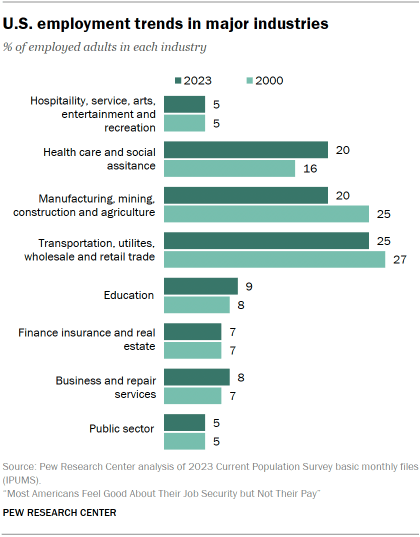
Employment growth over the last two decades has been much greater in some industries than others.
For example, 20% of workers are employed in the health care and social assistance industries as of 2023, up from 16% in 2000. This partly reflects the country’s aging population.
In turn, a smaller share of workers are now employed in manufacturing, mining, construction and agriculture (20%, down from 25% in 2000).
Certificates and licenses
Many workers demonstrate mastery of the skills or knowledge needed for a job by holding a professional certificate or license. Today, 26% of workers ages 25 and older have a professional certificate or license, and the share has not changed much since 2015 (when the Census Bureau began asking about certificates).
Often a worker needs a formal degree to qualify for a certificate, so workers with a formal degree are more likely to have a professional certificate than those without one. About a third of workers ages 25 and older with at least a bachelor’s degree (35%) have a professional certificate or license, compared with 8% of those who have not finished high school.
How the adult workforce has changed since 2000
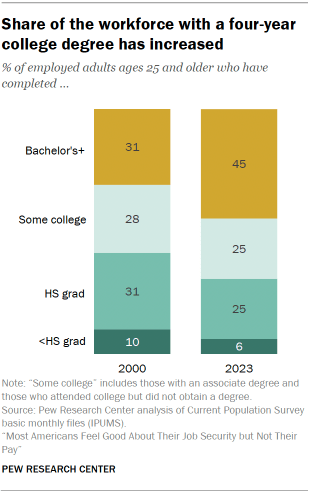
The country’s population is slowly changing, and the adult workforce has also changed in some similar ways over the past two decades:
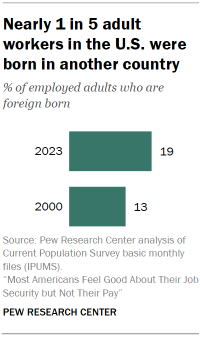
- Education: 45% of today’s workers ages 25 and older have at least a bachelor’s degree, compared with 31% in 2000. The share of workers who have some college education, a high school diploma or did not finish high school have each declined since 2000.
- Age: The median age of an adult worker is 42, up from 39 in 2000. Today, more than a third of the adult workforce (34%) is age 50 or older, compared with 24% in 2000.
- Race and ethnicity: Hispanic and Asian workers account for growing shares of the adult workforce. For example, 19% of adult workers today are Hispanic, up from 12% in 2000; 7% are Asian, up from 4%. White workers now make up 60% of the adult workforce, down from 71% in 2000, while the share of workers who are Black has not changed much (12% today vs. 11% in 2000).
- Nativity: 19% of adult workers are immigrants, versus 13% in 2000.
- Gender: 47% of the adult workforce are women, similar to 46% in 2000.




